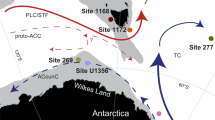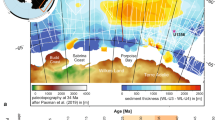Abstract
High-amplitude, rapid climate fluctuations are common features of glacial times. The prominent changes in air temperature recorded in the Greenland ice cores1,2 are coherent with shifts in the magnitude of the northward heat flux carried by the North Atlantic surface ocean3,4; changes in the ocean's thermohaline circulation are a key component in many explanations of this climate flickering5. Here we use stable-isotope and other sedimentological data to reveal specific oceanic reorganizations during these rapid climate-change events. Deep water was generated more or less continuously in the Nordic Seas during the latter part of the last glacial period (60 to 10 thousand years ago), but by two different mechanisms. The deep-water formation occurred by convection in the open ocean during warmer periods (interstadials). But during colder phases (stadials), a freshening of the surface ocean reduced or stopped open-ocean convection, and deep-water formation was instead driven by brine-release during sea-ice freezing. These shifting magnitudes and modes nested within the overall continuity of deep-water formation were probably important for the structuring and rapidity of the prevailing climate changes.
This is a preview of subscription content, access via your institution
Access options
Subscribe to this journal
Receive 51 print issues and online access
$199.00 per year
only $3.90 per issue
Buy this article
- Purchase on Springer Link
- Instant access to full article PDF
Prices may be subject to local taxes which are calculated during checkout



Similar content being viewed by others
References
Dansgaard,W. et al. Evidence for general instability of past climate from a 250-kyr ice core record. Nature 364, 218–220 (1993).
Grootes,P. M., Stuvier,M., White,J. W. C., Johnsen,S. & Jouzel,J. Comparison of oxygen isotope records from the GISP2 and GRIP Greenland Ice cores. Nature 366, 552–554 (1993).
Bond,G. et al. Correlation between climate records from North Atlantic sediments and Greenland ice. Nature 365, 143–147 (1993).
Bond,G. C. & Lotti,R. Iceberg discharges into the North Atlantic on millennial timescales during the last glaciation. Science 267, 1,005–1,010 (1995).
Broecker,W. S. Thermohaline circulation, the Achilles heel of our climate system: Will man made CO2 upset the current balance? Science 278, 1,582–1,588 (1997).
Rasmussen,T., Thomsen,E., Labeyrie,L. & van Weering,T. C. E. Circulation changes in the Faeroe–Shetland Channel correlating with cold events during the last glacial period 58–10 ka BP. Geology 24, 937–940 (1996).
Shackleton,N. J. Oxygen isotopes, ice volume and sea level. Quat. Sci. Rev. 6, 183–190 (1987).
Shackleton,N. J. Attainment of isotopic equilibrium between ocean water and the benthonic foraminifera genus Uvigirina: Isotopic changes in the ocean during the last glacial. Colloques Int. CNRS 219, 203–210 (1974).
Manabe,S. & Stouffer,R. J. Simulation of abrupt climatic change induced by freshwater input to the North Atlantic Ocean. Nature 378, 165–167 (1995).
Manabe,S. & Stouffer,R. J. Coupled ocean–atmosphere model response to freshwater input: Comparison to younger Dryas event. Paleoceanography 12, 321–336 (1997).
Craig,H. & Gordon,L. I. in Stable Isotope in Oceanographic Studies and Paleotemperatures (ed. Tongiorgi, T.) 9–130 (Cons. Nazional Rich. Lab. Geol. Nucl., Pisa, Italy, 1965).
Zahn,R. et al. Thermohaline instability in the north Atlantic during meltwater events: Stable isotope and ice rafted detritus records from core SO75-26KL, Portuguese margin. Paleoceanography 12, 696–710 (1997).
Oppo,D. W. & Lehman,S. J. Suborbital timescale variability of North Atlantic Deep Water during the past 200,000 years. Paleoceanography 10, 901–910 (1995).
Oppo,D. W. & Lehman,S. J. Mid-depth circulation of the subpolar North Atlantic during the last glacial maximum. Science 259, 1,148–1,152 (1993).
Lehman,S. J., Wright,D. G. & Stocker,T. F. in Ice in the Climate System (ed. Peltier, W. R.) 187–209 (NATO ASI Series I, Vol. 12, Springer, Berlin, 1993).
Grootes,P. M. & Stuvier,M. Oxygen 18/16 variability in Greenland snow and ice with 10-3–105-year time resolution. J. Geophys. Res. 102, 26,455–26,470 (1997).
Mayewski,P. A. et al. Major feature and forcing of high-latitude northern hemisphere atmospheric circulation using a 110,000-year-long glaciochemical series. J. Geophys. Res. 102, 26,345–26,366 (1997).
Broecker,W. S. The great ocean conveyor. Oceanography 4, 79–89 (1991).
Berger,W. H. & Jansen,E. in The Younger Dryas (eds. Troelstra, S. R. et al.) 61–105 (Royal Dutch Academy of Scientific Processes, Amsterdam, Netherlands, 1995).
Cortijo,E. et al. Changes in sea surface hydrology associated with Heinrich event 4 in the North Atlantic Ocean between 40° and 60° N. Earth Planet. Sci. Lett. 146, 29–45 (1997).
Korsun,S. A. & Polyak,L. V. Distribution of benthic foraminiferal morphogroups in the Barents Sea. Oceanology 29, 838–844 (1989).
Jansen,E., Bleil,U., Henrich,R., Kringstad,L. & Slettemark,B. Paleoenvironmental changes in the Norwegian Sea and the Northwest Atlantic during the last 2.8 m.y.: Deep Sea Drilling Project/Ocean Drilling Program sites 610, 642, 643 and 644. Paleoceanography 3, 563–581 (1988).
Graham,D. W., Corliss,B. H., Bender,M. L. & Keigwin,L. D. Carbon and oxygen disequilibria of recent deep-sea bethic foraminifera. Mar. Micropaleontol. 6, 483–497 (1981).
Bard,E., Arnold,M. & Hamelin,B. Present status of the radiocarbon calibration for the last Pleistocene. GEOMAR-Rep. 15, 52–53 (1992).
Martinson,D. G. et al. Age dating and the orbital theory of the ice ages: Development of a high resolution 0 to 300,000-year chronostratigraphy. Quat. Res. 27, 1–29 (1987).
Meese,D. A. et al. Preliminary depth-age scale of the GISP2 ice core. CRREL Spec. Rep. 94-1 (US Army Cold Region Research and Engineering Laboratory, Hanover, NH, 1987).
Bender,M. et al. Climate correlations between Greenland and Antarctica during the past 100,000 years. Nature 372, 663–666 (1994).
Labeyrie,L. D., Duplessy,J. C. & Blanc,P. L. Variation in mode of formation and temperature of oceanic deep waters over the past 125,000 years. Nature 327, 477–482 (1987).
Weinelt,M. et al. Ice free Nordic Seas during the last glacial maximum? Potential sites of deepwater formation. Paleoclimates 1, 283–309 (1996).
Fairbanks,R. G. A 17,000-year glacio-eustatic sea level record: influence of glacial melting rates on the Younger Dryas event and deep-ocean circulation. Nature 342, 637–642 (1989).
Acknowledgements
We thank L. Labeyrie, and the science party and crew of the Marion Dufresne and the IMAGES program, C. Kissel, E. Boyle and T. Rasmussen. We acknowledge the support of the French agencies MENRT, TAAF, CNRS/INSU and IFRTP. We also thank S. Østerhus, R. Søraas and O. Hansen. This work was funded by the Norwegian Science Foundation and the Environment and Climate program of the European Union.
Author information
Authors and Affiliations
Corresponding author
Supplementary information
Rights and permissions
About this article
Cite this article
Dokken, T., Jansen, E. Rapid changes in the mechanism of ocean convection during the last glacial period. Nature 401, 458–461 (1999). https://doi.org/10.1038/46753
Received:
Accepted:
Issue Date:
DOI: https://doi.org/10.1038/46753
This article is cited by
-
The PaleoJump database for abrupt transitions in past climates
Scientific Reports (2023)
-
Active Nordic Seas deep-water formation during the last glacial maximum
Nature Geoscience (2022)
-
Evolution of the North Atlantic Current and Barents Ice Sheet as revealed by grain size populations in the northern Norwegian Sea during the last 60 ka
Acta Oceanologica Sinica (2021)
-
An ice–climate oscillatory framework for Dansgaard–Oeschger cycles
Nature Reviews Earth & Environment (2020)
-
Eurasian Ice Sheet collapse was a major source of Meltwater Pulse 1A 14,600 years ago
Nature Geoscience (2020)
Comments
By submitting a comment you agree to abide by our Terms and Community Guidelines. If you find something abusive or that does not comply with our terms or guidelines please flag it as inappropriate.



